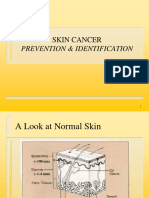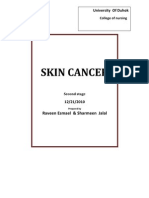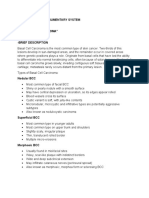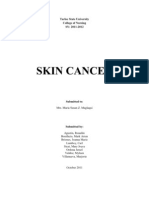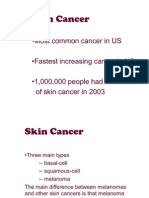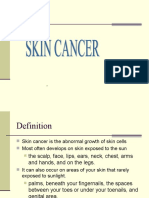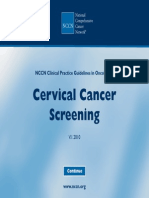0 ratings0% found this document useful (0 votes)
54 viewsSkin Cancer Project
Skin Cancer Project
Uploaded by
api-431068727Basal cell carcinoma and squamous cell carcinoma are two common types of non-melanoma skin cancer. Basal cell carcinoma forms in the lower epidermis and appears as a transparent bump, most often on sun-exposed areas like the face. It is caused by mutations in basal cells from sun exposure. Squamous cell carcinoma forms in the middle and outer layers of the skin and symptoms include firm red bumps or scabs, most often on sun-exposed areas. It is also caused by mutations in squamous cells from ultraviolet radiation like sunlight. Both cancers are generally treatable but can recur or spread if not addressed. Preventing overexposure to UV rays can help reduce the risk of developing these skin cancers.
Copyright:
© All Rights Reserved
Available Formats
Download as DOCX, PDF, TXT or read online from Scribd
Skin Cancer Project
Skin Cancer Project
Uploaded by
api-4310687270 ratings0% found this document useful (0 votes)
54 views9 pagesBasal cell carcinoma and squamous cell carcinoma are two common types of non-melanoma skin cancer. Basal cell carcinoma forms in the lower epidermis and appears as a transparent bump, most often on sun-exposed areas like the face. It is caused by mutations in basal cells from sun exposure. Squamous cell carcinoma forms in the middle and outer layers of the skin and symptoms include firm red bumps or scabs, most often on sun-exposed areas. It is also caused by mutations in squamous cells from ultraviolet radiation like sunlight. Both cancers are generally treatable but can recur or spread if not addressed. Preventing overexposure to UV rays can help reduce the risk of developing these skin cancers.
Original Title
skin cancer project
Copyright
© © All Rights Reserved
Available Formats
DOCX, PDF, TXT or read online from Scribd
Share this document
Did you find this document useful?
Is this content inappropriate?
Basal cell carcinoma and squamous cell carcinoma are two common types of non-melanoma skin cancer. Basal cell carcinoma forms in the lower epidermis and appears as a transparent bump, most often on sun-exposed areas like the face. It is caused by mutations in basal cells from sun exposure. Squamous cell carcinoma forms in the middle and outer layers of the skin and symptoms include firm red bumps or scabs, most often on sun-exposed areas. It is also caused by mutations in squamous cells from ultraviolet radiation like sunlight. Both cancers are generally treatable but can recur or spread if not addressed. Preventing overexposure to UV rays can help reduce the risk of developing these skin cancers.
Copyright:
© All Rights Reserved
Available Formats
Download as DOCX, PDF, TXT or read online from Scribd
Download as docx, pdf, or txt
0 ratings0% found this document useful (0 votes)
54 views9 pagesSkin Cancer Project
Skin Cancer Project
Uploaded by
api-431068727Basal cell carcinoma and squamous cell carcinoma are two common types of non-melanoma skin cancer. Basal cell carcinoma forms in the lower epidermis and appears as a transparent bump, most often on sun-exposed areas like the face. It is caused by mutations in basal cells from sun exposure. Squamous cell carcinoma forms in the middle and outer layers of the skin and symptoms include firm red bumps or scabs, most often on sun-exposed areas. It is also caused by mutations in squamous cells from ultraviolet radiation like sunlight. Both cancers are generally treatable but can recur or spread if not addressed. Preventing overexposure to UV rays can help reduce the risk of developing these skin cancers.
Copyright:
© All Rights Reserved
Available Formats
Download as DOCX, PDF, TXT or read online from Scribd
Download as docx, pdf, or txt
You are on page 1of 9
Basal Cell Carcinoma:
What is Basal Cell Carcinoma?
Basal cell carcinoma is one of the top skin cancers. This type of cancer is a
nonmelanoma skin cancer which means it forms in the lower part of the epidermis. This
is on the outer layer of the skin (National Cancer Institute). Basal cell carcinoma starts
off in basal cells, which is a skin cell that produces new ones as old ones die off. It often
shows up as a transparent bump on the skin. It shows up in areas where the skin is
exposed to sunlight like the face.
What are the symptoms?
This cancer occurs because of sun exposer. The parts of your body that are exposed
which are most likely to be your head and your neck have a high risk of getting Basel
cell carcinoma. The legs and other parts of the body have a lower chance of getting. It
the beginning stages it shows as a change on the skin by a type of growth or sore.
White, skin color or pink bump: This bump is able to be seen through a bit.
The little blood vessels are visible. People with darker skin tone, it may be a bit
harder to see though the surface. These dumps are most likely to appear on the
anywhere on the face, neck, or ears. The wound may pop and scab.
A brown, black or blue wound: This wound may have dark spots with a bump
and see through border around the area.
A flat, scabby, reddish area: The ended are bumpier and overtime it can
worsen in size. It is common it has it on the back or chest of the body.
A white, waxy, scar-like wound: There is no actual border to the area. It is
morpheaform basal cell carcinoma. It is the least common out of all of the four
appearances. It is easily overlooked but it may be a sign of a cancer or even
invasion of some sort.
*See a doctor if you see any of these appearances on your skin
What are the causes?
This skin cancer occurs because of one of skin basal cells develops a mutation. Basel
cells are found on the bottom of the epidermis which is the outer most layer of the skin.
Basel cells make the new skin cells and as the produce new skin, they push the old skin
cells towards the surface where they can fall off eventually. This process is controlled by
the DNA of the basal cells. The mutation causes DNA of the basal cell to grow rapidly
and keep growing when it was usually it should die off. The accumulation of the many
basal cells turn into a cancerous tumor and the dump appears on the skin.
Ultraviolet light and other causes: The mutation is caused by ultraviolet
radiation which is found from the sun, tanning booths, or even tanning lamps.
Other reasons have an impact on the reason why the mutation occurs however
they still haven’t been discovered.
What are some risk factors?
Sun exposure: Chronic time spent in the sun or in tanning booths increases the
chances of getting this basal cell carcinoma. Living in an area where it is sunny
most of the time will also increase the chance. Having severe sunburn especially
when you’re a child will raise the risk.
Radiation therapy: If a person has radiation therapy for psoriasis, acne, or other
skin conditions it may increase the chance.
Fair skin: People with freckles, easily burn, have light colored eyes, red, or blond
hair have a higher chance.
Gender: Men are most likely to get this cancer rather than women.
Age: After the age of 50 this cancer is most likely to develop.
Family history: This cancer is most likely to occur more than once. Also, if
family history shows skin cancers there is a high chance of developing this
cancer.
Immune-suppressing drugs: Medications that slow down your immune system
increase the rise of cancer especially when having a transplant surgery. This will
allow the cancer to spread to other parts of the body.
Exposure to arsenic: Arsenic is a toxic metal that found in the environment. It is
found in the environment, so we are all exposed to it to some extent but if you
are a farmer or work near this metal then it is dangerous for the cancer.
Inherited syndromes: Race genetic diseases often lead to basal cell carcinoma.
Nevoid basal cell carcinoma syndrome makes multiple basal cell carcinomas and
well as problems in the bone, skin, nervous system, eyes, and endocrine glands.
Xeroderma pigmentosum has sensitivity to the sun and risk of skin cancer.
People with this condition have basically cannot do anything to repair damage to
the skin from ultraviolet light.
What are complications?
Recurrence: It is common for basal cell carcinoma to recur, often in the same
spot.
Increase chance of other types of cancers: History of basal cell carcinoma
lead to cancers like squamous cell carcinoma.
Cancer that spreads: Rare cases of basal cell carcinoma may destroy muscle,
nerves, and even bone. This can spread to other parts of the body.
What are some preventions?
Avoid sunlight: When the sun rays are at its highest, it must be avoided. Even
during winter, the hours of 10am to 4pm should be avoided.
Use sunscreen: A sunscreen of at least 15 SPF, blocks both UVA and UVB
types of radiation from the sun should be good. You should reapply the
sunscreen every two hours or even more often.
Wearing protective clothing: Sunscreen doesn’t provide full coverage from UV
rays, so clothing is the best way of covering up. Wearing sunglasses also help to
provide full protection.
Avoid tanning beds: The UV rays is the reason why this cancer occurs, and
tanning beds are full of these rays. The best thing is to avoid them.
Familiarity with your skin: Seeing changes with your skin is important when
having the symptoms of basal cell carcinoma. Knowing what is normal and what
is not is helpful.
What is the treatment?
First dermatologists ask a series of questions then they do a skin exam. The treatment
is:
Electrodesiccation and curettage: ED&C is used to remove smaller basal cell
carcinomas. Surgeons remove the surface of the cancer with a blade and then
control the bleeding with electric needle.
Surgical excision: The doctor cuts out the cancerous lesion and a bit of the
healthy skin surrounding it. They look at it under the microscope to make sure
the cancer is all taken out.
Freezing: This kills the cancerous cells by freezing them with liquid nitrogen
(cryosurgery). It is good for cancer that are on the surface. It has to be done in
multiple cessions so there is no nerve damage.
Mohs surgery: The doctor removes the cancer cells layer by layer, examining
each layer under the microscope until the cancer is gone. This is usually the
most effective for cancers that are on the face and that are deep.
Creams: Basal cell carcinoma that is on the surface can be treated with
imiquimod and fluorouracil.
Medications: Basal cell carcinoma that advanced to other parts of the body may
need vismodegib or sonidegib. These block the signals from making anymore
basal cell carcinoma.
Squamous Cell Carcinoma:
What is Squamous Cell Carcinoma?
It is a common skin cancer that develops in the middle and outer layer of the skin.
Usually not life threatening but may be in some cases. It may grow when not treated
and cause other complications. Usually caused by the skin being in prolonged exposure
to ultraviolet (UV) radiation, from sunlight, from tanning beds, or tanning lamps.
Avoiding this radiation helps avoid this cancer. It is found anywhere on the body and
can be dangerous as time grows.
What are the symptoms?
The symptoms are most often form sun exposed skin such as your face, hands, ears,
and/ or lips. However, this cancer can occur anywhere on the body. The signs are:
Firm, red bump
A flat sore that is scabby
A sore or bump on or under a scar
Scabby patch on the lip that can be later an open sore
A red sore inside the mouth
A red patch in anus or genitals
*If the sore or scab did not heal in 2 month you should see a doctor
What are the causes?
Squamous cell carcinoma occurs when squamous cell develops a mutation. In a regular
squamous cell, new cells will push old cells to the surface and the old will die off. DNA
errors will cause the cells to grow out of control and cause squamous cell carcinoma.
Ultraviolet light and other causes: The mutation is caused by ultraviolet
radiation which is found from the sun, tanning booths, or even tanning lamps.
Other reasons have an impact on the reason why the mutation occurs however
they still haven’t been discovered. There is other reason why this cancer occurs
like being exposed to toxic substances or a weakend immune system.
What are some risk factors?
Sun exposure: Chronic time spent in the sun or in tanning booths increases the
chances of getting this squamous cell carcinoma. Living in an area where it is
sunny most of the time will also increase the chance. Having severe sunburn
especially when you’re a child will raise the risk. If you do not cover your skin with
clothing or sunblock it will lead to a higher chance.
Using tanning beds: These beds have a lot of ultraviolet radiation which will
lead to squamous cell carcinoma.
Fair skin: People with freckles, easily burn, have light colored eyes, red, or blond
hair have a higher chance.
A history of precancerous skin lesions: Having actinic keratosis or Bowen's
disease for example will cause squamous cell carcinoma.
Family history: This cancer is most likely to occur more than once. Also, if
family history shows skin cancers there is a high chance of developing this
cancer.
Personal history: Having squamous cell carcinoma once will cause the chances
of recurring to occur.
Weakened immune system: Weakened immune systems, leukemia, lymphoma,
take medication that slow down the immune system or even have had a
transplant have a risk of getting squamous cell carcinoma.
Rare genetic disorder: Xeroderma pigmentosum caused extreme sensitivity to
sunlight and increase the chance of getting cancers.
What are some preventions?
Avoid sunlight: When the sun rays are at its highest, it must be avoided. Even
during winter, the hours of 10am to 4pm should be avoided.
Use sunscreen: A sunscreen of at least 15 SPF, blocks both UVA and UVB
types of radiation from the sun should be good. You should reapply the
sunscreen every two hours or even more often.
Wearing protective clothing: Sunscreen doesn’t provide full coverage from UV
rays, so clothing is the best way of covering up. Wearing sunglasses also help to
provide full protection.
Avoid tanning beds: The UV rays is the reason why this cancer occurs, and
tanning beds are full of these rays. The best thing is to avoid them.
Familiarity with your skin: Seeing changes with your skin is important when
having the symptoms of basal cell carcinoma. Knowing what is normal and what
is not is helpful.
What is the treatment?
First dermatologists ask a series of questions then they do a skin exam. The treatment
is:
Electrodesiccation and curettage: ED&C is used to remove smaller squamous
cell carcinomas. Surgeons remove the surface of the cancer with a blade and
then control the bleeding with electric needle.
Curettage and cryotherapy: Similar to ED&C after the tumor removed, the base
and edges are treated with liquid nitrogen.
Laser therapy: A beam of light stops the growth and with some damage but
have a risk of bleeding, swelling, or scaring.
Surgical excision: The doctor cuts out the cancerous lesion and a bit of the
healthy skin surrounding it. They look at it under the microscope to make sure
the cancer is all taken out.
Radiation therapy: Using high beams to kill cancer cells. May be an option for
deep tumors and people would cannot go under surgery.
Freezing: This kills the cancerous cells by freezing them with liquid nitrogen
(cryosurgery). It is good for cancer that are on the surface. It has to be done in
multiple cessions so there is no nerve damage.
Mohs surgery: The doctor removes the cancer cells layer by layer, examining
each layer under the microscope until the cancer is gone. This is usually the
most effective for cancers that are on the face and that are deep.
Creams: Squamous cell carcinoma that is on the surface can be treated with
imiquimod and fluorouracil.
Medications: Squamous cell carcinoma that advanced to other parts of the body
may need vismodegib or sonidegib. These block the signals from making
anymore basal cell carcinoma (Squamous cell carcinoma of the skin).
Malignant Melanoma:
What is Malignant Melanoma?
This cancer is serious, and it affects the part where the cells produces melanin. Melanin
is the pigment that gives your skin color. Ultraviolent radiation increases the chances of
getting melanoma. The reason why is unknown. Limiting sunlight helps prevent
melanoma. It is increasing in people under 40 and in women. Knowing in the begging
stages of melanoma is most likely curable.
What are the symptoms?
Melanomas can occur anywhere on the body. They are most likely to occur anywhere
where there is a lot of sun exposer like legs, face, and back. Melanomas can also occur
on the soles of your feet even though it doesn’t get sun exposer. Common signs are:
Change in a mole
New pigment growth
Normal moles usually look tan, brown, or black with a border around the normal skin.
Usual an oval and ¼ inch. Many moles develop by the age of 50 and existing moles
many change in color.
Unusual moles usual helps when thinking of ABCDE
Asymmetrical shape: moles with irregular shape
Border: moles with irregular borders like notched or scalloped
Change in color: Uneven color
Diameter: New growth larger than ¼ inch
Evolving: looking for changes such as inching and or bleeding
Hidden melanomas: Parts of your body that do not get much sun exposer are like toes,
feet, and genitals. Hidden areas include:
Under the nail: Acral-lentiginous melanoma is a rare. Found on palms of hands
or soles of the feet. More common in darker skin tones.
In mouth, digestive tract, urinary tract or vagina: Mucosal melanoma occurs
in the mucous membrane. This lines the nose, mouth, esophagus, anus, urinary
tract and vagina.
In the eye: Eye melanoma may cause vision changes and can be caught during
an eye exam.
*See a doctor if you see changes in the skin
What are the causes?
Occurs when something goes wrong in melanin-producing cells. Skin cell that produces
new ones as old ones die off. When mutations occur it often shows up as a bump on the
skin because of the cancerous cells.
Ultraviolet light and other causes: The mutation is caused by ultraviolet
radiation which is found from the sun, tanning booths, or even tanning lamps.
Other reasons have an impact on the reason why the mutation occurs however
they still haven’t been discovered.
What are some risk factors?
Sun exposure: Chronic time spent in the sun or in tanning booths increases the
chances of getting this melanoma. Living in an area where it is sunny most of the
time will also increase the chance. Having severe sunburn especially when
you’re a child will raise the risk. If you do not cover your skin with clothing or
sunblock it will lead to a higher chance.
Using tanning beds: These beds have a lot of ultraviolet radiation which will
lead to squamous cell carcinoma.
Fair skin: People with freckles, easily burn, have light colored eyes, red, or blond
hair have a higher chance.
A history of precancerous skin lesions: Having actinic keratosis or Bowen's
disease for example will cause squamous cell carcinoma.
Family history: If family history shows skin cancers there is a high chance of
developing this cancer.
Having many moles or unusual moles: Having more than 50 normal moles
increase melanoma risk. It may be hard to know changes due to this.
Weakened immune system: Weakened immune systems, leukemia, lymphoma,
take medication that slow down the immune system or even have had a
transplant have a risk of getting melanoma.
Rare genetic disorder: Xeroderma pigmentosum caused extreme sensitivity to
sunlight and increase the chance of getting cancers.
What are some preventions?
Avoid sunlight: When the sun rays are at its highest, it must be avoided. Even
during winter, the hours of 10am to 4pm should be avoided.
Use sunscreen: A sunscreen of at least 15 SPF, blocks both UVA and UVB
types of radiation from the sun should be good. You should reapply the
sunscreen every two hours or even more often.
Wearing protective clothing: Sunscreen doesn’t provide full coverage from UV
rays, so clothing is the best way of covering up. Wearing sunglasses also help to
provide full protection.
Avoid tanning beds: The UV rays is the reason why this cancer occurs, and
tanning beds are full of these rays. The best thing is to avoid them.
Familiarity with your skin: Seeing changes with your skin is important when
having the symptoms of basal cell carcinoma. Knowing what is normal and what
is not is helpful.
What is the treatment?
First dermatologists ask a series of questions then they do a skin exam. The treatment
is:
Chemotherapy: Uses drugs to destroy cancer cells. It can also be given in a
vein in your arm or leg called isolated limb perfusion.
Surgical excision: The doctor cuts out the cancerous lesion and a bit of the
healthy skin surrounding it. They look at it under the microscope to make sure
the cancer is all taken out.
Radiation therapy: Using high beams to kill cancer cells. May be an option for
deep tumors and people would cannot go under surgery.
Biological therapy: Boots to fight cancer by using the immune system. Side
effects may be flu, chills, fever, and muscle aches.
Targeted therapy: Uses mediations designed to target cancers. Side effects
may be fever, chills, dehydration, and skim problems (Melanoma).
You might also like
- WHO Classification of Tumours of Haematopoietic and Lymphoid Tissues PDFDocument423 pagesWHO Classification of Tumours of Haematopoietic and Lymphoid Tissues PDFAlejandra Arely López NegreteNo ratings yet
- Melanoma BrochureDocument2 pagesMelanoma Brochureapi-284351148No ratings yet
- Basal Cell Carcinoma: CausesDocument5 pagesBasal Cell Carcinoma: CausesRini LianingsihNo ratings yet
- Skin CancerDocument37 pagesSkin CancerSangita Sonwane100% (1)
- DOI03semSkC Skin Cancer - KhomeiniDocument34 pagesDOI03semSkC Skin Cancer - Khomeinikhaira ummahNo ratings yet
- Terapi SCC Kemo RadiasiDocument42 pagesTerapi SCC Kemo RadiasiAndreNo ratings yet
- Prevention & Identification: Skin CancerDocument25 pagesPrevention & Identification: Skin Cancermkman100% (1)
- Raveen Esmael & Sharmeen Jalal: º Niversity of DuhokDocument12 pagesRaveen Esmael & Sharmeen Jalal: º Niversity of DuhokRaveenmayiNo ratings yet
- Skin Cancer: I. Overview of The DisorderDocument3 pagesSkin Cancer: I. Overview of The DisorderSung ChiiNo ratings yet
- Sunbathing Another Bad HabitDocument25 pagesSunbathing Another Bad HabitEftychia PapanikolaouNo ratings yet
- Skin Care Awareness CJ 10 KinDocument9 pagesSkin Care Awareness CJ 10 KinLkin100% (1)
- DOI03semSkC Skin CancerDocument36 pagesDOI03semSkC Skin CancermkmanNo ratings yet
- Basal Cell CarcinomaDocument11 pagesBasal Cell Carcinomaerwansyah1990No ratings yet
- Skin CancerDocument32 pagesSkin CancerniishantttNo ratings yet
- Spesimen DarahDocument7 pagesSpesimen DarahrezaNo ratings yet
- SKIN CANCER by Shahid and Nawaira PthologyDocument31 pagesSKIN CANCER by Shahid and Nawaira PthologyShahid BashirNo ratings yet
- CASE STUDY #4 Integumentary System (Basal Cell Carcinoma)Document5 pagesCASE STUDY #4 Integumentary System (Basal Cell Carcinoma)Lerma PagcaliwanganNo ratings yet
- Types of CancerDocument10 pagesTypes of CancerStudies 123No ratings yet
- Mrs. Maria Susan Z. MaglaquiDocument5 pagesMrs. Maria Susan Z. MaglaquiRon Agustin JrNo ratings yet
- Skin Cancer: By: Kausthubhi KillamsettiDocument33 pagesSkin Cancer: By: Kausthubhi KillamsettiKausthubhi KillamsettiNo ratings yet
- What Is Melanoma Skin Cancer?Document58 pagesWhat Is Melanoma Skin Cancer?Ruslan KamilNo ratings yet
- Skin CancerDocument47 pagesSkin CancerdwarfalopeNo ratings yet
- Skin CancerDocument34 pagesSkin Cancerhhh4rvvmh5No ratings yet
- Information Drive Task 2 JAVIER, C.T 10DDocument46 pagesInformation Drive Task 2 JAVIER, C.T 10DXianNo ratings yet
- Presentation 3Document14 pagesPresentation 3Linda Lam100% (1)
- Melanoma Skin Cancer OverviewDocument39 pagesMelanoma Skin Cancer OverviewHardy WibowoNo ratings yet
- Skin CancerDocument5 pagesSkin Cancerapi-646942864No ratings yet
- MELANOMADocument16 pagesMELANOMAniishantttNo ratings yet
- Ms 214 Cca Melanoma Poster v4Document1 pageMs 214 Cca Melanoma Poster v4api-273098842No ratings yet
- Skin Cancer Research Paper 1Document4 pagesSkin Cancer Research Paper 1api-646942864No ratings yet
- Reported By: Porlas, Mary Josephine N. BN41Document15 pagesReported By: Porlas, Mary Josephine N. BN41matrixtrinity100% (1)
- Skin CancerDocument5 pagesSkin CancerVania GarciaaNo ratings yet
- Beware of MelanomaDocument5 pagesBeware of MelanomaBala SubramanianNo ratings yet
- Skin Cancer Editing DraftDocument4 pagesSkin Cancer Editing Draftapi-646942864No ratings yet
- Biology Investigatory ProjectDocument14 pagesBiology Investigatory Projectrajarshibasu06No ratings yet
- Fact Sheet Squamous Cell Carcinoma Oct 2013Document10 pagesFact Sheet Squamous Cell Carcinoma Oct 2013Triven Nair HutabaratNo ratings yet
- Basal Cell Carsinoma: Novita Hianto 07120020021 BedahDocument9 pagesBasal Cell Carsinoma: Novita Hianto 07120020021 BedahFerdy Erawan100% (1)
- EssayDocument3 pagesEssayapi-318356118No ratings yet
- AnaPhy Skin Cancer Case Study-BASCODocument6 pagesAnaPhy Skin Cancer Case Study-BASCOChristine Jane BascoNo ratings yet
- Project IntoductionDocument6 pagesProject IntoductionRadhwan KhateebNo ratings yet
- Malignant Melanoma Early Stage. A guide for patientsDocument10 pagesMalignant Melanoma Early Stage. A guide for patientsyellowbieNo ratings yet
- Squamous Cell Carcinoma: Delivering The Best in CareDocument8 pagesSquamous Cell Carcinoma: Delivering The Best in CareReynalth Andrew SinagaNo ratings yet
- Melanoma: SymptomsDocument5 pagesMelanoma: SymptomsStudies 123No ratings yet
- How The Effect of Sun Rays To The SkinDocument5 pagesHow The Effect of Sun Rays To The Skinarafah daiNo ratings yet
- Spot The Difference Skin Cancer FlyerDocument2 pagesSpot The Difference Skin Cancer FlyerAditi MorarkaNo ratings yet
- Skin CancerDocument14 pagesSkin Cancerpoonamtrivedi2021No ratings yet
- Melanoma Skin CancerDocument62 pagesMelanoma Skin CancerHardy WibowoNo ratings yet
- Skin CancerDocument32 pagesSkin CancerPradeep KumarNo ratings yet
- ABout Melanoma Skin CancerDocument11 pagesABout Melanoma Skin CancerOdair Braz JuniorNo ratings yet
- Ultraviolet Radiation Induces Skin Cancer in Developing WorldDocument4 pagesUltraviolet Radiation Induces Skin Cancer in Developing WorldmmuruganandamNo ratings yet
- Counselling Skin LesionDocument3 pagesCounselling Skin LesionSabrina11No ratings yet
- Skin CancerDocument14 pagesSkin CancerGusti Ayu Sattwika Pramita100% (1)
- PenileDocument2 pagesPenileAREOLA Vera SophiaNo ratings yet
- 2008-Malignant Epidermal TumorsDocument58 pages2008-Malignant Epidermal Tumorsapi-19916399No ratings yet
- Background Information On The Effect of Exposure To Immediate Sunlight Without Sunscreen Correlating With Increased Skin Cancer RisksDocument3 pagesBackground Information On The Effect of Exposure To Immediate Sunlight Without Sunscreen Correlating With Increased Skin Cancer RisksSelenaNo ratings yet
- Squamous Cell CarcinomaDocument3 pagesSquamous Cell CarcinomaJohn HanNaNo ratings yet
- Squamous Cell Skin CancerDocument2 pagesSquamous Cell Skin CancerToni Mas IrwandaNo ratings yet
- MelanomaDocument11 pagesMelanomabumdazzblonde3No ratings yet
- Skin Cancer Signs and TreatmentDocument2 pagesSkin Cancer Signs and TreatmentPrincessArsenalNo ratings yet
- 06 - Chapter 2Document26 pages06 - Chapter 2SINARASUNo ratings yet
- Multiple Myeloma: Supervisor: Prepared byDocument12 pagesMultiple Myeloma: Supervisor: Prepared byAbdulbast Salah IsmahilNo ratings yet
- Aloe Vera Final WordDocument1 pageAloe Vera Final WordDavid ivanovicNo ratings yet
- Radiobiological Modeling of Interplay Between Accelerated Repopulation and Altered Fractionation Schedules in Head and Neck CancerDocument6 pagesRadiobiological Modeling of Interplay Between Accelerated Repopulation and Altered Fractionation Schedules in Head and Neck CancerLal RintluangaNo ratings yet
- 760PDDocument1 page760PDDavid OlmosNo ratings yet
- Melanoma Cancer PresentationDocument13 pagesMelanoma Cancer PresentationMerlyn JeejoNo ratings yet
- Cervical Cancer Screening: NCCN Clinical Practice Guidelines in Oncology™Document0 pagesCervical Cancer Screening: NCCN Clinical Practice Guidelines in Oncology™Tania Rodriguez IncerNo ratings yet
- A Combo of Fasting Plus Vitamin C Is Effective For Hard-To-treat Cancers, Study Shows - ScienceDailyDocument3 pagesA Combo of Fasting Plus Vitamin C Is Effective For Hard-To-treat Cancers, Study Shows - ScienceDailyaesocidNo ratings yet
- Form Registrasi Kanker RSDocument10 pagesForm Registrasi Kanker RSRika WandiNo ratings yet
- Coloretal - IccrDocument120 pagesColoretal - IccrAna CanastraNo ratings yet
- CancerDocument87 pagesCancerdrzikaNo ratings yet
- CytoDocument5 pagesCytosikandgauravNo ratings yet
- Jco.2022.40.16 Suppl.e14002Document1 pageJco.2022.40.16 Suppl.e14002hamzaNo ratings yet
- Kemoterapi Anak: Ignasia Nila Siwi Psik Stikes Madani 9 November 2021Document10 pagesKemoterapi Anak: Ignasia Nila Siwi Psik Stikes Madani 9 November 2021Sri RahmniaNo ratings yet
- Content: Certificate Acknowledgement Declaration Whatiscancer Warning Signalsforcancer TreatmentofcancerDocument15 pagesContent: Certificate Acknowledgement Declaration Whatiscancer Warning Signalsforcancer TreatmentofcancerAnjali ChelakNo ratings yet
- Biomedicines 11 00128Document13 pagesBiomedicines 11 00128dmandatari7327No ratings yet
- Cancer Immunotherapy: BY Neha P Patel M.SC Part I Sem IiDocument36 pagesCancer Immunotherapy: BY Neha P Patel M.SC Part I Sem IiAxsa AlexNo ratings yet
- Grading and Staging of TumorsDocument11 pagesGrading and Staging of TumorsJahanzaib Bashir100% (1)
- HemanthcvDocument11 pagesHemanthcvsureshb52No ratings yet
- Art16 PDFDocument11 pagesArt16 PDFignacioNo ratings yet
- Chapter 4 - Reading and Writing AssignmentDocument2 pagesChapter 4 - Reading and Writing Assignmentteemo no JutsuNo ratings yet
- 2010 TNM Staging Colorectal CADocument2 pages2010 TNM Staging Colorectal CAbubbrubb20063998No ratings yet
- Penile CancerDocument58 pagesPenile CancerPatrascu CristiNo ratings yet
- Burkitt's LymphomaDocument22 pagesBurkitt's LymphomaClementNo ratings yet
- Bed Site Teaching Onko Pak Bah November 2021Document5 pagesBed Site Teaching Onko Pak Bah November 2021Yudistira YunusNo ratings yet
- LM-2501 Dr. Naveen Kumar Mummudi Dept - of Radiation Oncology CMC Vellore Tamilnadu Ph.Document28 pagesLM-2501 Dr. Naveen Kumar Mummudi Dept - of Radiation Oncology CMC Vellore Tamilnadu Ph.purnima4uonly100% (2)
- BPH Smith English-26-30 PDFDocument5 pagesBPH Smith English-26-30 PDFnovi camiumNo ratings yet
- Aml Fact SheetDocument2 pagesAml Fact SheetVinod KSNo ratings yet
- The Role of Hypofractionated Radiotherapy in ProstDocument10 pagesThe Role of Hypofractionated Radiotherapy in ProstАнастасия АнохинаNo ratings yet
- Oncogenic VirusesDocument5 pagesOncogenic VirusesManoj KhadseNo ratings yet






